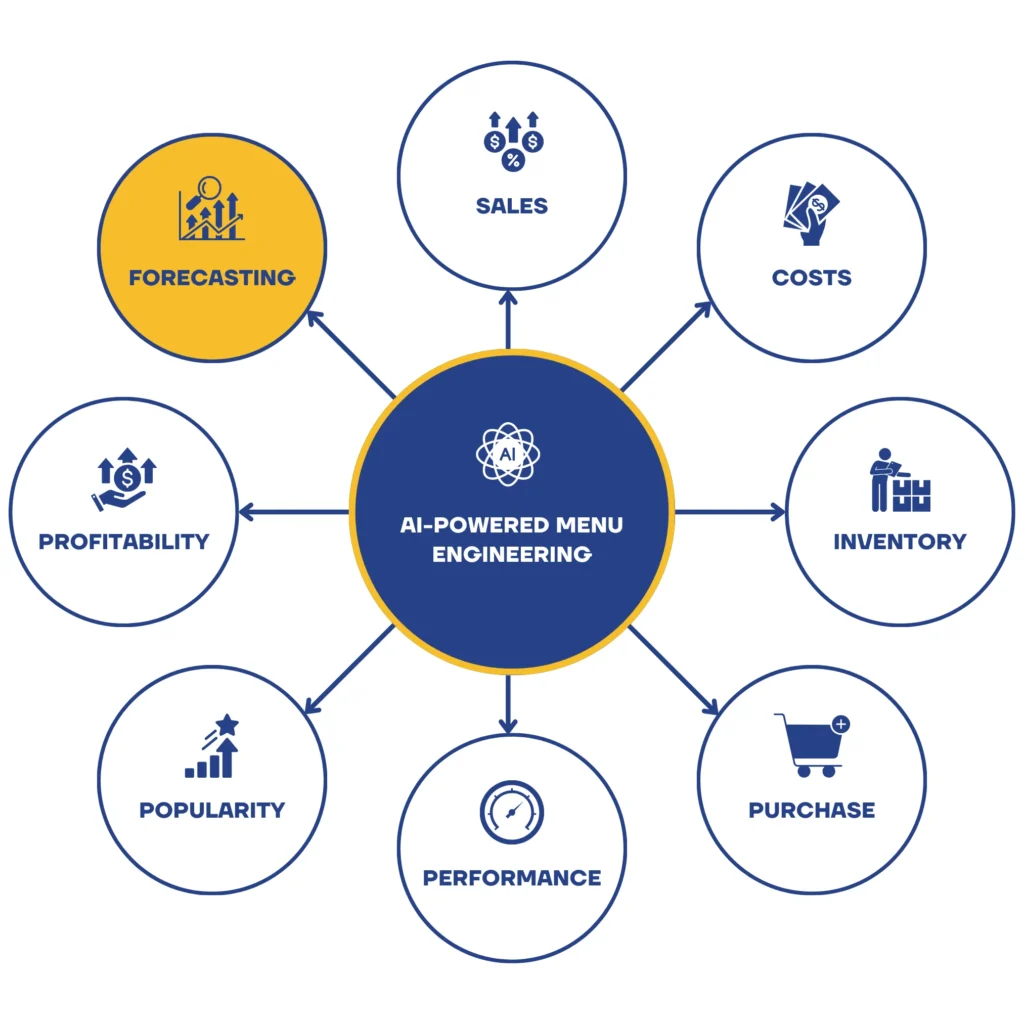AI-Powered Menu Engineering for F&B Businesses
Growth Optimization Performance
Menu engineering is a strategic approach used in the food and beverage (F&B) industry to optimize menu offerings for profitability and customer satisfaction.

How AI-Powered Menu Engineering Works
Polaris Technology's AI-powered menu engineering works by leveraging advanced algorithms to analyze vast amounts of data including sales trends, customer preferences, and cost structures.
By identifying patterns and insights, AI algorithms recommend strategic menu adjustments to maximize profitability and enhance customer satisfaction.
By categorizing items into different segments (such as stars, plowhorses, puzzles, and dogs), menu engineering can identify which items are driving profits and which may need adjustments or removal, forecasting profitability.
This process helps restaurants maximize revenue, minimize costs, and enhance overall dining experiences for customers.
Benefits of Menu Engineering
Profit Maximization
Menu engineering analysis allows the evaluation of menu items' performance. Adjusting pricing or placement accordingly, menu engineering helps businesses maximize profitability.
Cost Control
Restaurant menu engineering allows businesses to identify high-cost, low-profit items and either adjust pricing, re-engineer recipes, or remove them from the menu to control costs.
Operational Efficiency
Menu engineering optimizes menu offerings, streamlining kitchen operations and reducing complexity. This leads to faster order processing and minimized wait times, which creates operational efficiency.
Problems Menu Engineering Solves
Faster Decision Making
Menu engineering provides valuable insights into customer preferences, allowing businesses to make informed decisions about menu changes, promotions, and future offerings.
Customer Satisfaction
By improving operational efficiency, customer orders are processed faster, and staff have more time to focus on delivering memorable experiences.
Time Saving
Menu engineering replaces manual work with automated processes and insights, freeing up time for restaurateurs to concentrate on enhancing customer experiences and enjoying more freedom in their operations.
Menu Engineering FAQ
Menu engineering in restaurants involves strategically analyzing and designing menus to boost profitability and customer appeal. It categorizes dishes by their sales performance and cost, highlighting top items to improve menu efficiency. AI-powered menu engineering offers real-time analysis of sales data, instantly identifying profitable and popular items while providing recommendations to enhance the performance and profitability of less popular dishes.
Polaris ERP’s AI-Powered menu engineering uses sales data to provide information on what items were most and least sold during a specific period. It also utilizes revenue data to spot the high-profit and low-profit items, as well as cost data to calculate the contribution margins (cost of ingredients and labor), popularity data, and menu item attributes such as pricing, descriptions, and visual presentations to influence customer perception.
By analyzing the profitability and popularity of each menu item, menu engineering enables businesses to identify high-cost, low-margin items that may be contributing to excessive food costs. With this insight, restaurateurs can make strategic decisions such as adjusting portion sizes, substituting ingredients, or eliminating underperforming dishes to optimize their menu for profitability. Additionally, menu engineering allows businesses to strategically price menu items based on their cost and popularity, ensuring that each item contributes positively to overall profitability. Overall, menu engineering empowers businesses to make data-driven decisions that effectively control food costs while maintaining a profitable and competitive menu.
The advantage of AI-powered menu engineering lies in its ability to analyze vast amounts of data quickly and accurately, providing actionable insights to optimize menu offerings for profitability and customer satisfaction. By leveraging AI algorithms, businesses can make data-driven decisions and adapt their menus in real-time to meet changing market demands and consumer preferences.
Based on menu engineering analysis, businesses can make strategic changes such as adjusting menu layouts, optimizing pricing strategies, and revamping menu descriptions to highlight high-profit items and enhance overall profitability. Additionally, menu engineering may prompt businesses to streamline their offerings by removing underperforming items or introducing new dishes based on customer preferences and market trends.
By looking into the data from across sales, revenue, cost, etc., menu engineering is able to provide recommendations on how to boost the menu’s profitability, suggesting menu item combos, chef’s recommendation, or offering rewards and loyalty points to clients ordering specific menu items. It also boosts profitability by cutting operational costs, by suggesting items that can be repurposed, or pointing to the supplier offering the lower prices for specific ingredients to cut costs. Find out more information here.
Take Charge of Menu Performance Today.
Stop Guessing, Start Growing!
Related Blogs
Menu Engineering Updates
Continue reading our blogs on Menu Engineering
